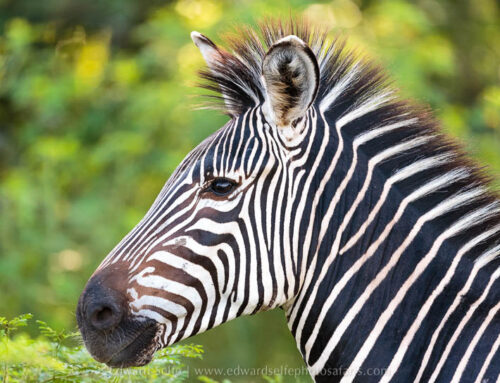Through the Lens: My Favourite 5……Landscapes.
Number 5: Flooded Dambo
Canon EOS 1D Mk 4, 24-105mm f4 lens at f4, ISO 320, 1/1600sec, EV 0 and Evaluative metering.
Landscapes are a much more difficult technique than portraits of animals and birds, in my opinion. How often have you seen a beautiful scene and snapped a photo, only to find that it doesn’t do justice to the view in front of you? Several elements have to come together to make a good landscape photo.
I would suggest that the most important is to convey the scale of the situation or, put another way, ensure that there is something that guides the viewer into the shot. If all the content of the shot is relatively far away, the image will appear “flat” with no perspective.
I do not claim to be a fantastic landscape photographer, but I live in a place where the opportunities for landscape photography are vast. I’m starting off my favourite 5 with a shot of the dambo in front of our house. In this case, the details reflected in the mirror-glass water are enough to draw the viewer into the shot. The overhanging trees from the right provide a tunnel through which the viewer can travel.
With no content in the immediate foreground, f4 provides enough depth of field for this shot.

Number 4: Storm Brewing
Canon EOS 40D, 17-85mm f4-5.6 lens at f6.3, ISO 200, 1/800sec, EV 0 and Evaluative metering.
One of my all-time favourite shots; storm clouds brew in the near distance as Luangwa threatens a final storm before the dry season sets in for good.
The road provides a “leading-line” into the shot, and conveniently the orange gravel provides a nice colour against the blue-grey sky. The tree on the right hand side balances the composition which would otherwise be heavily weighted towards the left where the road leads the eye.

Number 3: Sunset over the Mwaleshi
Canon EOS 1D Mark 4, 17-40mm f4 lens at f8, ISO 200, 1/250sec, EV -1/3 and Evaluative metering.
There had to be a sunset in here somewhere! This shot is not only a memory of an oustanding sunset but also of a great time I spent in the North Luangwa National Park where I was filming lions with a crew for the Discovery Channel. You might have seen the program “Predator”?
This shot only just works in my opinion; yes the sunset is beautiful and the ‘starburst’ effect of the sun’s rays filtering through the clouds is fantastic, but without the sliver of river in the foreground, the shot would be flat. Equally, the curve in the river which is visible on the left hand side draws your eye across the shot and into the distance at the back.
Here, with an unstabilised lens, I had to take care to get a sharp shot at 1/250 second, but I wanted the lowest ISO possible so that I could get a wide dynamic range and the best colour representation.

Number 2: Road to Where?
Canon EOS 7D, 17-40mm f4 lens at f11, ISO 400, 1/40sec, EV 0 and Evaluative metering.
Near where we live there is a beautiful area of Mopane forest with sandy roads leading through it. It’s stunning at any time of year, but in the mid dry season, when the light is cascading through the drying leaves, it is at its best.
I was resting on the back seat of my vehicle, using the seat to get a bit of height to see further down the track. The path is a leading line and takes the eye into the photo, and the colours and shadows do the rest!
I never trusted the Canon 7D at higher ISOs than 800 so I was reluctant even to go to ISO 800 in this case. I wanted plenty of detail in the foreground trees and the background undergrowth, so I needed plenty of depth of field. I just had to hold it still!

(Depth of field is a strange thing; the depth of field is affected by 1) the distance of the subject from the camera 2) the length of the lens 3) the aperture. But not always in the same way; to get in focus two objects, one 1m from the camera, and the other 3m from the camera, will require a much smaller aperture than if the objects were 5m and 7m away. Equally, to get the same two objects in focus with a 300mm lens will require a much smaller aperture than with a 100mm lens. More on this in a post soon.)
Number 1: Luangwa Overflow
Canon EOS 7D, 17-40mm f4 lens at f10, ISO 100, 1/50sec, EV 0 and Evaluative metering.
The Luangwa River in full flow is really something to see. Here, from a boat, we are looking up the Mushilashi River, one of the seasonal flood rivers that feeds the Luangwa. During the dry season, we cross the Mushilashi in vehicles just at the point of the trees on the left side!! Hard to imagine!
I love this shot because the colours are so intense, the cloud formations are beautiful and the details in the water provide interest in the foreground.
Arguably, I should have traded some depth of field, or some ISO speed to get a faster shutter speed, but at the time, I didn’t think of it! Even so,1/50sec is fast enough to give me a sharp shot at 31mm as long as I hold it still! Without doubt, my favourite landscape shot.




